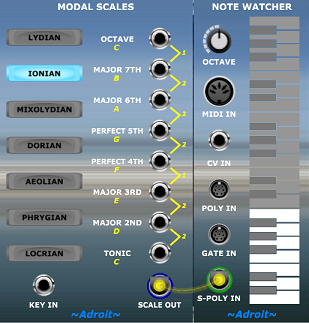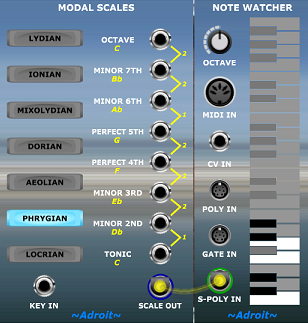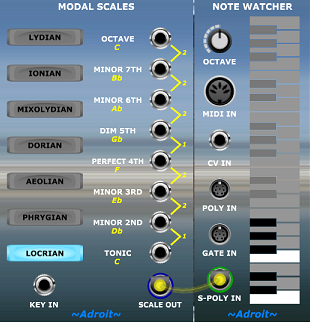
The Modal Scales module produces pitch voltages representing the notes in each of the modal scales.
A fairly detailed description of modal scales is available here.
Each modal scale has a slightly different feel.
The pattern of intervals are as follows…
Lydian: 1 2 3 #4 5 6 7
Ionian: 1 2 3 4 5 6 7
Mixolydian: 1 2 3 4 5 6 b7
Dorian: 1 2 b3 4 5 6 b7
Aeolian: 1 2 b3 4 5 b6 b7
Phyrgian: 1 b2 b3 4 5 b6 b7
Locrian: 1 b2 b3 4 b5 b6 b7
The Ionian mode is identical to the major scale while the Aeolian mode is identical to the natural minor scale.
The Mixolydian and Dorian modes are interesting as they kind of bridge the gap between the perhaps overly familiar terrain of major and minor scales.
The buttons on the left of the module select which modal scale is used.
The buttons are ordered so that the brightest scales are at the top and the darkest at the bottom.
The small yellow numbers show the number of semitones difference in pitch between the outputs.
A regular 1 V/Octave control voltage fed to the module’s KEY IN socket controls which of the 12 keys is used. If nothing is connected then the key defaults to C.
The KEY IN signal is used to transpose the scale by simple addition so will handle octave offsets and non-standard tuning, but it’s also used to update the helpful yellow note value labels. So the module is expecting the KEY IN voltage to be relatively stable. For clarity (and to a lesser extent from an efficiency point of view) it’s therefore best if things like vibrato or glides are added after this module .
Individual pitch outputs can be used for transposition, to build chords or be used in generative music patches.
The commonest application is perhaps to connect the S-Poly scale signal output from the SCALE OUT socket to Adroit modules that utilize scales.
The images below show all seven modes in the key of C and you can see that as we descend down the order that the buttons are arranged in, more and more flattened notes are introduced.







Availability
The Modal Scales module is part of LSSP XL.